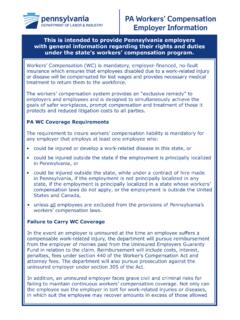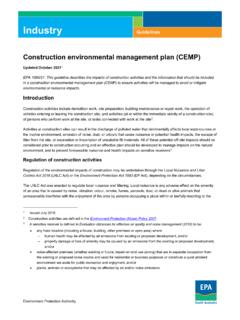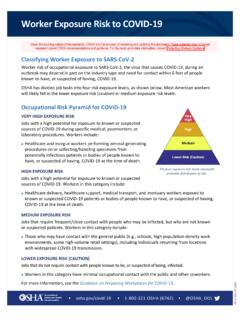Transcription of Beyond the Data: Understanding the Impact of COVID-19 on ...
1 Beyond the data: Understanding the Impact of COVID-19 on BAME groups Beyond the Data: Understanding the Impact of COVID-19 on BAME communities About Public Health England Public Health England exists to protect and improve the nation's health and wellbeing, and reduce health inequalities. We do this through world-leading science, research, knowledge and intelligence, advocacy, partnerships and the delivery of specialist public health services. We are an executive agency of the Department of Health and Social Care, and a distinct delivery organisation with operational autonomy. We provide government, local government, the NHS, Parliament, industry and the public with evidence-based professional, scientific and delivery expertise and support. Public Health England Wellington House 133-155 Waterloo Road London SE1 8UG.
2 Tel: 020 7654 8000. Twitter: @PHE_uk Facebook: Crown copyright 2020. You may re-use this information (excluding logos) free of charge in any format or medium, under the terms of the Open Government Licence To view this licence, visit OGL. Where we have identified any third-party copyright information you will need to obtain permission from the copyright holders concerned. Published June 2020. PHE publications PHE supports the UN. gateway number: GW-1307 Sustainable Development Goals 2. Beyond the Data: Understanding the Impact of COVID-19 on BAME Communities Contents Executive summary 4. Acknowledgements 12. Impact of COVID-19 in BAME populations: a rapid literature review 13. Looking Beyond the data: stakeholder engagement 25. Stakeholders requests for action 48. Resources 52.
3 References 59. Appendices 62. Glossary 68. 3. Beyond the Data: Understanding the Impact of COVID-19 on BAME Communities Executive summary There is clear evidence that COVID-19 does not affect all population groups equally. Many analyses have shown that older age, ethnicity, male sex and geographical area, for example, are associated with the risk of getting the infection, experiencing more severe symptoms and higher rates of death. This work has been commissioned by the Chief Medical Officer for England to understand the extent that ethnicity impacts upon risk and outcomes. The PHE review of disparities in the risk and outcomes of COVID-19 shows that there is an association between belonging to some ethnic groups and the likelihood of testing positive and dying with COVID-19 .
4 Genetics were not included in the scope of the review. This review found that the highest age standardised diagnosis rates of COVID-19 per 100,000 population were in people of Black ethnic groups (486 in females and 649 in males) and the lowest were in people of White ethnic groups (220 in females and 224. in males). An analysis of survival among confirmed COVID-19 cases showed that, after accounting for the effect of sex, age, deprivation and region, people of Bangladeshi ethnicity had around twice the risk of death when compared to people of White British ethnicity. People of Chinese, Indian, Pakistani, Other Asian, Caribbean and Other Black ethnicity had between 10 and 50% higher risk of death when compared to White British. Death rates from COVID-19 were higher for Black and Asian ethnic groups when compared to White ethnic groups.
5 This is the opposite of what is seen in previous years, when the all-cause mortality rates are lower in Asian and Black ethnic groups. Comparing to previous years, all-cause mortality was almost 4 times higher than expected among Black males for this period, almost 3 times higher in Asian males and almost 2 times higher in White males. Among females, deaths were almost 3 times higher in this period in Black, Mixed and Other females, and times higher in Asian females compared with times in White females. These analyses did not account for the effect of occupation, comorbidities or obesity. These are important factors because they are associated with the risk of acquiring COVID-19 , the risk of dying, or both. Other evidence has shown that when comorbidities are included, the difference in risk of death between ethnic groups among hospitalised patients is greatly reduced.
6 4. Beyond the Data: Understanding the Impact of COVID-19 on BAME Communities This report builds upon the PHE epidemiological review by summarising a rapid literature review and external stakeholder engagement. Review of the wider literature A rapid review of the published literature was undertaken to identify if inequalities exist in how BAME groups are affected by COVID-19 infection when compared to the White British population. The review also sought to understand the social and structural determinants of health that may Impact disparities in COVID-19 incidence, treatment, morbidity, and mortality in BAME groups. There is some evidence which supports the hypothesis that BAME groups are more likely to test positive for COVID-19 than those identifying as White British but more needs to be done for other minority ethnic groups, there is insufficient evidence to draw conclusions.
7 The evidence describing risk of severe COVID-19 is mixed. More, high quality research is needed before any conclusions can be reached. The emerging evidence suggests excess mortality due to COVID-19 in BAME populations. Individuals of Black African or Black Caribbean and Asian ethnic groups may have the highest increased risk. The literature review and stakeholder feedback indicate that risks associated with COVID-19 transmission, morbidity, and mortality can be exacerbated by the housing challenges faced by some members of BAME groups. The most recent research from the UK suggests that both ethnicity and income inequality are independently associated with COVID-19 mortality. Individuals from BAME groups are more likely to work in occupations with a higher risk of COVID-19 exposure.
8 They are more likely to use public transportation to travel to their essential work. Historic racism and poorer experiences of healthcare or at work may mean that individuals in BAME groups are less likely to seek care when needed or as NHS staff are less likely to speak up when they have concerns about Personal Protective Equipment (PPE) or risk. Stakeholder engagement We also carried out engagement with a broad range of stakeholders. In total 17. sessions were hosted involving over 4,000 people with a broad range of interests in BAME issues. These sessions provided further insights into the factors that may be influencing the relationship and Impact of COVID-19 on BAME communities and strategies for addressing inequalities. PHEs role was to capture the feedback received and were not responsible for confirming the evidence base behind the points raised.
9 Stakeholders expressed deep dismay, anger, loss and fear in their communities about the emerging data and realities of BAME groups being harder hit by the COVID-19 . 5. Beyond the Data: Understanding the Impact of COVID-19 on BAME Communities pandemic than others, exacerbating existing inequalities. Many had lost colleagues or family members to the disease, and nearly all are experiencing the Impact of the disease on their communities with the significant social, physical and mental health impacts and complications. Stakeholders acknowledged that while actions are already being undertaken, the results of the PHE review and other studies should be used to strengthen and accelerate efforts moving forward. Clear, visible and tangible actions, provided at scale were called for now with a commitment to address the underlying factors.
10 A summary of available resources available to support local action is provided in this report. The main themes emerging from the stakeholder sessions were as follows. Longstanding inequalities exacerbated by COVID-19 . It is clear from discussions with stakeholders that COVID-19 in their view did not create health inequalities, but rather the pandemic exposed and exacerbated longstanding inequalities affecting BAME groups in the UK. A wide variety of explanations for these have been examined, ranging from upstream social and economic factors to downstream biological factors (this review did not look at genetic factors). BAME. groups tend to have poorer socioeconomic circumstances which lead to poorer health outcomes. Data from the ONS and the PHE analysis confirmed the strong association between economic disadvantage and COVID-19 diagnoses, incidence and severe disease.
















